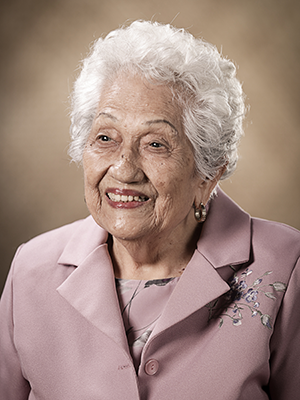Moved to CHagui’an Yigo

When they learned of the Japanese bombing at Sumai on 8 December 1941, many CHamorus hurried to hide. For most, it was several miles to safety, but for Rosario “Charo” Flores Leon Guerrero (1920 – ), it was just a walk two miles northwest from her home to a well-built and furnished family ranch at CHagui’an, Yigo.
Born to Ignacio Aguon Flores (Familian Cabesa) and Susanna Lujan Garcia, Leon Guerrero is the second to the oldest of eight siblings. Leon Guerrero’s childhood was typical of a CHamoru family. Her father was a farmer and her mother a homemaker. Leon Guerrero shadowed her mother and became an accomplished cook and seamstress at 16 years old.
A devout Baptist, she attended Sunday school with her family and enjoyed the fellowship of church members. A close friend, Father Jesus Baza Duenas, introduced Leon Guerrero to his cousin, whom she married in October 1941.
When the war came to Guam, Leon Guerrero was 21 and had only been married for two months. Her daughter Rosie was born in 1942, and they stayed at the ranch while her husband joined other CHamorus forced to clear a landing field for Japanese planes.
Shared what they had
Although safe at the ranch, Leon Guerrero still faced adversity, especially during the early months of the war. Very often, those passing through CHagui’an were given shelter, respite and food, and it was at the ranch that war information and experiences were exchanged. Leon Guerrero said that they were happy to share food since her father maintained the ranch very well with livestock, vegetables, fruit trees and dried corn. The fresh water was from an underground spring nearby. Wild deer and pigs were abundant. Since refrigeration was not available, meat that was cooked and not eaten the same day would be dried into jerky. Soap was made from coconut. Salt from the ocean.
Life was relatively normal under Japanese rule. Although restricted, travel was allowed for worship, and her family attended Sunday school where they prayed for deliverance and cherished the fellowship of their Baptist relatives.
It was in 1944 that Leon Guerrero experienced the cruelty of war. She witnessed the killing of her friend, Father Duenas.
I watched the Japanese soldiers. They kept beating him until he died.
Rosario Flores Leon Guerrero
Leon Guerrero also shared the story of a mother who was beaten for lighting a fire to warm milk for her infant. Leon Guerrero recalls that during the march to Manenggon, people were not allowed to stop to help those who were old or sick.
You had to be strong and show no emotion, or you would be beaten or beheaded. I will never forget that one woman lamenting that she didn’t realize that her baby died in her arms during the march.
Had to march to Manenggon while 8 months pregnant
The two-day trek through the jungle and hills from Yigo to Maimai then to Manenggon was extremely difficult for Leon Guerrero, who was eight months pregnant with her second child, Hilda. She would not have survived the trip if it were not for the assistance of her sister-in-law, who carried her daughter Rosie, and a friend, who carried the provisions and pulled the family goat, which had provided milk for Rosie.
Leon Guerrero’s faith sustained her and she prayed for deliverance. That day came on 21 July 1944 when the US Marines landed on the beaches of Asan and Hågat. Like many others, Leon Guerrero and her family were transported by the Marines from Manenggon to a camp at Pigo cemetery, where the conditions were horrible.
Pigo was a bloody battle field with unburied bodies. The river was polluted with human waste as many CHamorus had dysentery. There were no immediate shelters and the families laid on the ground among the dead Japanese soldiers. Leon Guerrero said you had to be strong to see all this.
Baby born at Pigo
With the birth of her second child imminent, Leon Guerrero spoke to a midwife in the camp, who delivered the baby a few days later. Leon Guerrero delivered her baby laid on a piece of wood with a blanket to cover her for privacy.
Regardless of the unsanitary conditions, Leon Guerrero’s second child, Hilda, was born healthy with no complications. Her husband, Pedro, was not present for the birth, because he was out scouting for Japanese stragglers. He was shot by one of them, but was able to recover quickly from the injury. Unfortunately though, Leon Guerrero’s mother fell ill and died just after Guam’s liberation.
Canned goods, mostly spam and corned beef, were available, but Leon Guerrero said her family preferred the nutritious hot meals that were cooked on the Navy ships and delivered to the Pigo camp.
Fresh out of the devastation of war, Leon Guerrero and Pedro started the recovery process. Pedro taught school, then worked for Land Management, eventually acquiring a seat as a senator in the First and Third Guam Congress.
Editor’s note: Reprinted and adapted, with permission, from Guam War Survivors Memorial Foundation by Marilyn Constance Aflague.
